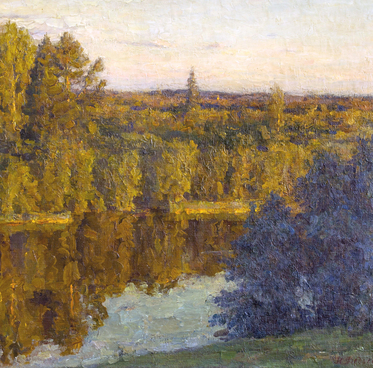Anatoly Vladimirovich Borodin (1935–2018) was born in the village of Anaseuli, Makharadze district of Georgia. He studied at the Moscow City Art School and graduated from the Moscow Polygraphic Institute.
His teachers were Andrey Dmitrievich Goncharov, Pavel Grigoryevich Zakharov and Gleb Timofeyevich Goroshchenko. As the subject of his graduation work, he chose the Russian Primary Chronicle (lit. — “The Tale of Bygone Years”), for which he made illustrations. After graduating from the Institute, Anatoly Borodin joined the Artists’ Union of the USSR.
From the 1970s, the artist lived for a long time in the village of Vidogoschi in the Kalininsky District of the Tver Oblast. He devoted many of his works to this village made in the technique of algraphy in which an aluminum plate is used to produce a flat image. At the same time, the artist’s preferred printmaking technique throughout his career was linocut.
Linocut appeared in the early 20th century, after the invention of linoleum and the need to print large-format works — posters. By using chisels of different sizes on such a surface, artists were able to achieve sharp contrasts.
Linocut is distinguished by laconic artistic means and expressive and picturesque lines, which are achieved due to the softness of the material. In this technique, artists can work rather quickly, use a large sheet size and color printing.
In 1992, Anatoly Vladimirovich Borodin received a gold medal of the Russian Academy of Arts for a series of linocuts “Over the Volga near Gorodnya”, and for a series of engravings depicting Moscow he was awarded the Moscow City Hall Prize in 2000.
The graphic artist traveled a lot in the USSR and Russia. He preserved his impressions of the tundra and the Russian North, as well as Central and South Russia in his graphic works. The Zavolzhsk Museum houses three works by Anatoly Borodin.
The linocut “Vereya” depicts an old provincial town
on the banks of the quiet Protva River, twenty-three kilometers from Mozhaysk.
The name of this town in Old Russian means “doorpost, post at the door and at
the gate”. This area repeatedly found itself in the thick of history — it
played an important role both in the War of 1812 and in the Great Patriotic
War.


